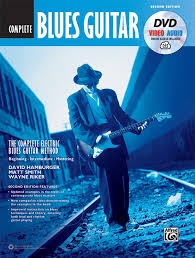 This book is a good value at under $30 because it is actually three books. The first is for beginners, the second, for “intermediate” students of the blues, and the third for “mastering” blues guitar. I mean, it is literally three books, each by a different author, with three separate tables of contents. There’s enough material to keep anyone busy for a very long time. But for me, it didn’t.
This book is a good value at under $30 because it is actually three books. The first is for beginners, the second, for “intermediate” students of the blues, and the third for “mastering” blues guitar. I mean, it is literally three books, each by a different author, with three separate tables of contents. There’s enough material to keep anyone busy for a very long time. But for me, it didn’t.
As a rank beginner (one year of experience), I only made it halfway through the first book until I got stalled and had to put it aside. I paged through the entire book to survey what else was going on there.
What happened? Well, maybe I’m a no-talent stupido, but by the fourth chapter I was struggling to understand. There’s a lot of unexplained information thrown up like roadblocks. No beginner’s book should do that. When I say beginner, this book starts by naming the six strings and showing the notes on the frets, and the difference between a whole note and a half note, so we’re talking beginner-beginner.
And yet quite often the book springs a mystery on you, such as in Lesson 48, which shows a TAB diagram but with black dots that are not musical notes spread over five frets and there are 12 of them. Alas, I only have five fingers on my left hand and the thumb is back where it should be, so what am I supposed to do with a TAB showing 12 notes? Even if one of them is a weird notation for a barre, that still leaves six others. I had to skip that lesson.
And that wasn’t the only stumbling block. In lesson 42 I am instructed to “Use left hand muting on the first of each pair of eighth notes in the following lesson.” I would have, but some of the chords used open strings. How would that work?
In Lesson 16 there is a well-labeled explanation of scale diagrams, with frets, tones, strings and fingers. Very helpful, except it’s not accurate. On the very next page, Lesson 18 shows a scale with numbers up to 12 right on the TAB lines where you were told to expect finger numbers. Obviously they have to be fret numbers. Finger numbers are absent, and below, where fret numbers are supposed to appear, nothing. So you don’t really know what to expect after that.
In Lesson 40 there is a line drawing of a left hand to show a two-fret stretch between fingers three and four while finger one is on a barre 4 frets away. Cool, except I couldn’t do it, my bad, but the diagram didn’t help by not labeling any of the frets, and the drawing did not show clearly which strings were fretted. By fooling around I found I could get a G7 out of it with a barre on the third fret but what the hell? Why were there no labels?
I realize that if I had a teacher, all would be revealed. But I don’t have a teacher, which is why I bought the book.
I checked out the DVD and found it to be not helpful. There are videos of a guy (only men) playing the lesson exercises, which he calls out by number (no on-screen staff or TABs), and describing what he’s doing, but there is no actual instruction. He doesn’t say things like “Put this finger there, and do this and then that, for these reasons.” Maybe some people learn better by watching. It didn’t help me any.
Still, I enjoyed what I did learn, and I’ll probably go back to the book someday when I am no longer a beginner.
The second, intermediate book, has more on rhythm, bending, vibrato, and a nice list of licks, from B.B. King to Joe Bonamassa. And yet, oddly, it starts out with “What is an Interval?” “What is a chord?” Why would you start with that on page 100, the beginning of the “intermediate level?” The answer is that the three “levels” were just thrown together into one book for marketing purposes. The whole is not greater than the sum of its parts and there’s a lot of redundancy.
The final “master’s” book does start out at a more advanced level, with instruction on shuffles, turnarounds, improvisational techniques, nice fills, and lots of good chord charts. It’s very interesting, but again, not the least integrated with the other two books.
I had hoped that the book + the DVD would substitute for a live teacher. That may have been a foolish idea. This book is a very detailed presentation, but it is not an instruction.
Hamburger, David; Smith, Matt; & Riker, Wayne. (2015). Complete Blues Guitar, Second Edition. Van Nuys, CA: Alfred Music, 312 pp., with DVD and online access code.
